Pulse-Modulated Radio-Frequency Alternating-Current-Driven Atmospheric-Pressure Glow Discharge for Continuous-Flow Synthesis of Silver Nanoparticles and Evaluation of Their Cytotoxicity toward Human Melanoma Cells
Abstract
1. Introduction
2. Materials and Methods
2.1. Reagents and Solutions
2.2. Plasma-Reaction System for the Continuous Synthesis of AgNPs
2.3. Response Surface Model and Optimization of AgNP Synthesis
2.4. Characterization of the AgNPs Synthesized under Defined Operating Conditions
2.5. Optical Emission Spectrometry
2.6. Purification of AgNPs
2.7. Determining the Efficiency of AgNP Synthesis
2.8. Cell Culture Conditions
2.9. Experimental Groups and Exposure Conditions
2.10. Necrotic Assay
3. Results and Discussion
3.1. Response Surface Regression Model
3.2. The Effects of Operating Parameters
3.3. Validation of the Response Surface Regression Model
3.4. Characterization of Synthesized AgNPs under Optimal Operating Conditions
3.5. Influence of the Synthesized AgNPs on Necrosis of Cancer Cells
4. Conclusions
Author Contributions
Funding
Conflicts of Interest
References
- Lansdown, A.B. Silver I: Its antibacterial properties and mechanism of action. J. Wound Care 2002, 11, 125–130. [Google Scholar] [CrossRef] [PubMed]
- Braun, E.; Eichen, Y.; Sivan, U.; Ben-Yoseph, G. DNA-templated assembly and electrode attachment of a conducting silver wire. Nature 1998, 391, 775. [Google Scholar] [CrossRef] [PubMed]
- Buzzi, S.; Galli, M.; Agio, M.; Loffler, J.F. Silver high-aspect-ratio micro-and nanoimprinting for optical applications. Appl. Phys. Lett. 2009, 94, 223115. [Google Scholar] [CrossRef]
- Son, W.K.; Youk, J.H.; Lee, T.S.; Park, W.H. Preparation of antimicrobial ultrafine cellulose acetate fibers with silver nanoparticles. Macromol. Rapid Commun. 2004, 25, 1632–1637. [Google Scholar] [CrossRef]
- Stamplecoskie, K.G.; Scaiano, J.C.; Tiwari, V.S.; Anis, H. Optimal size of silver nanoparticles for surface-enhanced Raman spectroscopy. J. Phys. Chem. C 2011, 115, 1403–1409. [Google Scholar] [CrossRef]
- Xia, B.; He, F.; Li, L. Metal-enhanced fluorescence using aggregated silver nanoparticles. Colloids Surf. A 2014, 444, 9–14. [Google Scholar] [CrossRef]
- Kulthong, K.; Srisung, S.; Boonpavanitchakul, K.; Kangwansupamonkon, W.; Maniratanachote, R. Determination of silver nanoparticle release from antibacterial fabrics into artificial sweat. Part. Fibre Toxicol. 2010, 7, 8. [Google Scholar] [CrossRef] [PubMed]
- Wang, K.; Huang, Q.; Qiu, F.; Sui, M. Non-viral delivery systems for the application in p53 cancer gene therapy. Curr. Med. Chem. 2015, 22, 4118–4136. [Google Scholar] [CrossRef] [PubMed]
- Zhang, B.; Wang, K.; Si, J.; Sui, M.; Shen, Y. Charge-Reversal Polymers for Biodelivery; Wiley-VCH Verlag GmbH & Co. KGaA: Weinheim, Germany, 2014; pp. 223–242. [Google Scholar]
- Banti, C.N.; Hadjikakou, S.K. Anti-proliferative and anti-tumor activity of silver(I) compounds. Metallomics 2013, 5, 569–596. [Google Scholar] [CrossRef] [PubMed]
- Zhang, X.F.; Liu, Z.G.; Shen, W.; Gurunathan, S. Silver nanoparticles: Synthesis, characterization, properties, applications, and therapeutic approaches. Int. J. Mol. Sci. 2016, 17, 1534. [Google Scholar] [CrossRef] [PubMed]
- Yezhelyev, M.V.; Gao, X.; Xing, Y.; Al-Hajj, A.; Nie, S.; O’Regan, R.M. Emerging use of nanoparticles in diagnosis and treatment of breast cancer. Lancet Oncol. 2006, 7, 657–667. [Google Scholar] [CrossRef]
- Gopinath, P.; Gogoi, S.K.; Chattopadhyay, A.; Ghosh, S.S. Implications of silver nanoparticle induced cell apoptosis for in vitro gene therapy. Nanotechnology 2008, 19, 075104. [Google Scholar] [CrossRef] [PubMed]
- Ortega, F.G.; Fernandez-Baldo, M.A.; Fernandez, J.G.; Serrano, M.J.; Sanz, M.I.; Diaz-Mochon, J.J.; Lorente, J.A.; Raba, J. Study of antitumor activity in breast cell lines using silver nanoparticles produced by yeast. Int. J. Nanomed. 2015, 10, 2021–2031. [Google Scholar]
- Zielinska, E.; Zauszkiewicz-Pawlak, A.; Wojcik, M.; Inkielewicz-Stepniak, I. Silver nanoparticles of different sizes induce a mixed type of programmed cell death in human pancreatic ductal adenocarcinoma. Oncotarget 2017 9, 4675–4697. [CrossRef]
- De Lima, R.; Seabra, A.B.; Duran, N. Silver nanoparticles: A brief review of cytotoxicity and genotoxicity of chemically and biogenically synthesized nanoparticles. J. Appl. Toxicol. 2012, 32, 867–879. [Google Scholar] [CrossRef] [PubMed]
- Akter, M.; Sikder, M.T.; Rahman, M.M.; Ullah, A.K.M.A.; Hossain, K.F.B.; Banik, S.; Hosokawa, T.; Saito, T.; Kurasaki, M. A systematic review on silver nanoparticles-induced cytotoxicity: Physicochemical properties and perspectives. J. Adv. Res. 2018, 9, 1–16. [Google Scholar] [CrossRef]
- Franci, G.; Falanga, A.; Galdiero, S.; Palomba, L.; Rai, M.; Morelli, G.; Galdiero, M. Silver nanoparticles as potential antibacterial agents. Molecules 2015, 18, 8856–8874. [Google Scholar] [CrossRef] [PubMed]
- Dzimitrowicz, A.; Motyka, A.; Jamroz, P.; Lojkowska, E.; Babinska, W.; Terefinko, D.; Pohl, P.; Sledz, W. Application of silver nanostructures synthesized by cold atmospheric pressure plasma for inactivation of bacterial phytopathogens from the genera Dickeya and Pectobacterium. Materials 2018, 11, 331. [Google Scholar] [CrossRef] [PubMed]
- Akolkar, R.; Sankaran, R.M. Charge transfer processes at the interface between plasmas and liquids. J. Vac. Sci. Technol. A 2013, 31, 050811. [Google Scholar] [CrossRef]
- Mariotti, D.; Sankaran, R.M. Microplasmas for nanomaterials synthesis. J. Phys. D Appl. Phys. 2010, 43, 323001. [Google Scholar] [CrossRef]
- Dzimitrowicz, A.; Jamroz, P.; Pogoda, D.; Nyk, M.; Pohl, P. Direct current atmospheric pressure glow discharge generated between a pin-type solid cathode and a flowing liquid anode as a new tool for silver nanoparticles production. Plasma Process. Polym. 2017, 14, e1600251. [Google Scholar] [CrossRef]
- De Vos, C.; Baneton, J.; Witzke, M.; Dille, J.; Godet, S.; Gordon, M.J.; Sankaran, R.M.; Reniers, F. A comparative study of the reduction of silver and gold salts in water by a cathodic microplasma electrode. J. Phys. D Appl. Phys. 2017, 50, 105206. [Google Scholar] [CrossRef]
- Thong, Y.L.; Chin, O.H.; Ong, B.H.; Huang, N.M. Synthesis of silver nanoparticles prepared in aqueous solutions using helium DC microplasma jet. Jpn. J. Appl. Phys. 2016, 55, 01AE19. [Google Scholar] [CrossRef]
- Ghosh, S.; Bishop, B.; Morrison, I.; Akolkar, R.; Scherson, D.; Sankaran, R.M. Generation of a direct-current, atmospheric-pressure microplasma at the surface of a liquid water microjet for continuous plasma-liquid processing. J. Vac. Sci. Technol. A 2015, 33, 021312. [Google Scholar] [CrossRef]
- Tochikubo, F.; Shimokawa, Y.; Shirai, N.; Uchida, S. Chemical reactions in liquid induced by atmospheric-pressure dc glow discharge in contact with liquid. Jpn. J. Appl. Phys. 2014, 53, 126201. [Google Scholar] [CrossRef]
- Tochikubo, F.; Shirai, N.; Uchida, S. Liquid-phase reactions induced by atmospheric pressure glow discharge with liquid electrode. J. Phys. Conf. Ser. 2014, 565, 012010. [Google Scholar] [CrossRef]
- Yan, T.; Zhong, X.; Rider, A.E.; Lu, Y.; Furman, S.; Ostrikov, K. Microplasma-chemical synthesis and tunablereal-time plasmonic responses of alloyed Au Ag nanoparticles. ChemComm 2014, 50, 3144–3147. [Google Scholar]
- Wang, R.; Zuo, S.; Zhu, W.; Zhang, J.; Zhu, W.; Becker, K.; Fang, J. Microplasma-assisted synthesis of colloidal gold nanoparticles and their use in the detection of cardiac troponin I (cTn-I). Plasma Process. Polym. 2014, 12, 380–891. [Google Scholar] [CrossRef]
- Huang, X.Z.; Zhong, X.X.; Lu, Y.; Li, Y.S.; Rider, A.E.; Furman, S.A.; Ostrikov, K. Plasmonic Ag nanoparticles via environment-benign atmospheric microplasma electrochemistry. Nanotechnology 2013, 24, 095604. [Google Scholar] [CrossRef] [PubMed]
- Chiang, W.H.; Richmonds, C.; Sankaran, R.M. Continuous-flow, atmospheric-pressure microplasmas: A versatile source for metal nanoparticle synthesis in the gas or liquid phase. Plasma Sources Sci. Technol. 2010, 19, 034011. [Google Scholar] [CrossRef]
- Richmonds, C.; Sankaran, R.M. Plasma-liquid electrochemistry: Rapid synthesis of colloidal metal nanoparticles by microplasma reduction of aqueous cations. Appl. Phys. Lett. 2008, 93, 131501. [Google Scholar] [CrossRef]
- Chang, F.C.; Richmonds, C.; Sankaran, R.M. Microplasma-assisted growth of colloidal Ag nanoparticles for point-of-use surface-enhanced Raman scattering applications. J. Vac. Sci. Technol. A 2010, 28, L5. [Google Scholar] [CrossRef]
- Santosh, V.S.; Kondeti, K.; Gangal, U.; Yatom, S.; Bruggeman, P.J. Ag+ reduction and silver nanoparticle synthesis at the plasma–liquid interface by an RF driven atmospheric pressure plasma jet: Mechanisms and the effect of surfactant. J. Vac. Sci. Technol. A 2017, 35, 061302. [Google Scholar]
- Ameer, F.S.; Varahagiri, S.; Benza, D.W.; Willett, D.R.; Wen, Y.; Wang, F.; Chumanov, G.; Anker, J.N. Tuning localized surface plasmon resonance wavelengths of silver nanoparticles by mechanical deformation. J. Phys. Chem. C 2016, 120, 20886–20895. [Google Scholar] [CrossRef] [PubMed]
- Calabrese, I.; Merli, M.; Turco-Liveri, M.L. Deconvolution procedure of the UV-vis spectra. A powerful tool for the estimation of the binding of a model drug to specific solubilisation loci of bio-compatible aqueous surfactant-forming micelle. Spectrochim. Acta A Mol. Biomol. Spectrosc. 2015, 142, 150–158. [Google Scholar] [CrossRef] [PubMed]
- Dzimitrowicz, A.; Lesniewicz, T.; Greda, K.; Jamroz, P.; Nyk, M.; Pohl, P. Production of gold nanoparticles using atmospheric pressure glow microdischarge generated in contact with a flowing liquid cathode—A design of experiments study. RSC Adv. 2015, 5, 90534–90541. [Google Scholar] [CrossRef]
- Dzimitrowicz, A.; Greda, K.; Lesniewicz, T.; Jamroz, P.; Nyk, M.; Pohl, P. Size-controlled synthesis of gold nanoparticles by a novel atmospheric pressure glow discharge system with a metallic pin electrode and a flowing liquid electrode. RSC Adv. 2016, 6, 80773–80783. [Google Scholar] [CrossRef]
- Bursac, Z.; Gauss, C.H.; Williams, D.K.; Hosmer, D.W. Purposeful selection of variables in logistic regression. Source Code Biol. Med. 2008, 3, 17. [Google Scholar] [CrossRef] [PubMed]
- Sleeper, A. Minitab® DeMYSTiFieD; Mc Graw Hill: New York, NY, USA, 2012. [Google Scholar]
- Thanh, N.T.K.; Maclean, N.; Mahiddine, S. Mechanisms of nucleation and growth of nanoparticles in solution. Chem. Rev. 2014, 114, 7610–7630. [Google Scholar] [CrossRef] [PubMed]
- Patel, J.; Nemcova, L.; Maguire, P.; Graham, W.G.; Mariotti, D. Synthesis of surfactant-free electrostatically stabilized gold nanoparticles by plasma-induced liquid chemistry. Nanotechnolgoy 2013, 24, 245604. [Google Scholar] [CrossRef] [PubMed]
- Dzimitrowicz, A.; Jamroz, P.; Greda, K.; Nowak, P.; Nyk, M.; Pohl, P. The influence of stabilizers on the production of gold nanoparticles by direct current atmospheric pressure glow microdischarge generated in contact with liquid flowing cathode. J. Nanopart. Res. 2015, 17, 185. [Google Scholar] [CrossRef] [PubMed]
- Mariotti, D.; Patel, J.; Svrcek, V.; Maguire, P. Plasma-liquid interactions at atmospheric pressure for nanomaterials synthesis and surface engineering. Plasma Process. Polym. 2012, 9, 1074–1085. [Google Scholar] [CrossRef]
- Mie, G. Beitrage zur optik truber medien, speziell kolloidaler metallosungen. Ann. Phys. 1908, 25, 377–445. [Google Scholar] [CrossRef]
- Greda, K.; Swiderski, K.; Jamroz, P.; Pohl, P. Flowing liquid anode atmospheric pressure glow discharge as an excitation source for optical emission spectrometry with the improved detectability of Ag, Cd, Hg, Pb, Tl, and Zn. Anal. Chem. 2016, 88, 8812–8820. [Google Scholar] [CrossRef] [PubMed]
- Jamroz, P.; Greda, K.; Pohl, P.; Zyrnicki, W. Atmospheric pressure glow discharges generated in contact with flowing liquid cathode: Production of active species and application in wastewater purification processes. Plasma Chem. Plasma Process. 2014, 34, 25–37. [Google Scholar] [CrossRef]
- Pereira-Lachataignerais, J.; Pons, R.; Panizza, P.; Courbin, L.; Rouch, J.; Lopez, O. Study and formation of vesicle systems with low polydispersity index by ultrasound method. Chem. Phys. Lipids 2006, 140, 88–97. [Google Scholar] [CrossRef] [PubMed]
- Nobbmann, U. Polydispersity—What Does It Mean for DLS and Chromatography? Available online: http://www.materials-talks.com/blog/2014/10/23/polydispersity-what-does-it-mean-for-dls-and-chromatography/ (accessed on 1 June 2018).
- Tomaszewska, E.; Soliwoda, K.; Kadziola, K.; Tkacz-Szczesna, B.; Celichowski, G.; Cichomski, M.; Szmaja, W.; Grobelny, J. Detection Limits of DLS and UV-Vis Spectroscopy in Characterization of Polydisperse Nanoparticles Colloids. J. Nanomater. 2013, 2013, 60. [Google Scholar] [CrossRef]
- Kaasalainen, M.; Aseyev, V.; von Haartman, E.; Karaman, D.S.; Makila, E.; Tenhu, H.; Rosenholm, J.; Salonen, J. Size, stability, and porosity of mesoporous nanoparticles characterized with light scattering. Nanoscale Res. Lett. 2017, 12, 74. [Google Scholar] [CrossRef] [PubMed]
- Kora, A.J.; Beedu, S.R.; Jayaraman, A. Size-controlled green synthesis of silver nanoparticles mediated by gum ghatti (Anogeissus latifolia) and its biological activity. Org. Med. Chem. Lett. 2012, 2, 17. [Google Scholar] [CrossRef] [PubMed]
- The American Cancer Society, Key Statistics for Melanoma Skin Cancer. Available online: https://www.cancer.org/cancer/melanoma-skin-cancer/about/key-statistics.html (accessed on 1 June 2018).
- Rosenberg, S.A.; Dudley, M.E. Adoptive cell therapy for the treatment of patients with metastatic melanoma. Curr. Opin. Immunol. 2009, 21, 233–240. [Google Scholar] [CrossRef] [PubMed]
- Sierra-Rivera, C.A.; Franco-Molina, M.A.; Mendoza-Gamboa, E.; Zapata-Benavides, P.; Tamez-Guerra, R.S.; Rodriguez-Padilla, C. Potential of colloidal or silver nanoparticles to reduce the growth of B16F10 melanoma tumors. Afr. J. Microbiol. Res. 2013, 7, 2745–2750. [Google Scholar] [CrossRef]
- Aftab, S.; Shah, A.; Nadhman, A.; Kurbanoglu, S.; Aysıl Ozkan, S.; Dionysiou, D.D.; Shukla, S.S.; Aminabhavi, T.M. Nanomedicine: An effective tool in cancer therapy. Int. J. Pharm. 2018, 540, 132–149. [Google Scholar] [CrossRef] [PubMed]
- Yuan, Y.G.; Peng, Q.L.; Gurnathan, S. Silver nanoparticles enhance the apoptotic potential of gemcitabine in human ovarian cancer cells: Combination therapy for effective cancer treatment. Int. J. Nanomed. 2017, 12, 6487–6502. [Google Scholar] [CrossRef] [PubMed]
- Greulich, C.; Braun, D.; Peetsch, A.; Diendorf, J.; Siebers, B.; Epple, M.; Koller, M. The toxic effect of silver ions and silver nanoparticles towards bacteria and human cells occurs in the same concentration range. RSC Adv. 2012, 2, 6981–6987. [Google Scholar] [CrossRef]
- Urbanska, K.; Pajak, B.; Orzechowski, A.; Sokolowska, J.; Grodzik, M.; Sawosz, E.; Szmidt, M.; Sysz, P. The effect of silver nanoparticles (AgNPs) on proliferation and apoptosis of in ovo cultured glioblastoma multiforme (GBM) cells. Nanoscale Res. Lett. 2015, 10, 98. [Google Scholar] [CrossRef] [PubMed]
- Zielinska, E.; Zauszkiewicz-Pawlak, A.; Wojcik, M.; Inkielewicz-Stepniak, I. Silver nanoparticles of different sizes induce a mixed type of programmed cell death in human pancreatic ductal adenocarcinoma. Oncotarget 2017, 9, 4675–4697. [Google Scholar] [CrossRef] [PubMed]
- Wang, K.; He, X.; Linthicum, W.; Mezan, R.; Wang, L.; Rojanasakul, Y.; Wen, Q.; Yang, Y. Carbon nanotubes induced fibrogenesis on nanostructured substrates. Environ. Sci. Nano 2017, 4, 689–699. [Google Scholar] [CrossRef] [PubMed]
- Zhang, L.; Webster, T. Nanotopography of biomaterials for controlling cancer cell function. In Biomaterials for Cancer Therapeutics, Diagnosis, Prevention and Therapy; Park, K., Ed.; Woodhead Publishing: Oxford, UK, 2013; pp. 461–487. [Google Scholar]
- Wang, K.; Bruce, A.; Mezan, R.; Kadiyala, A.; Wang, L.; Dawson, J.; Rojanasakul, Y.; Yang, Y. Nanotopographical modulation of cell function through nuclear deformation. Appl. Mater. Interfaces 2016, 8, 5082–5092. [Google Scholar] [CrossRef] [PubMed]

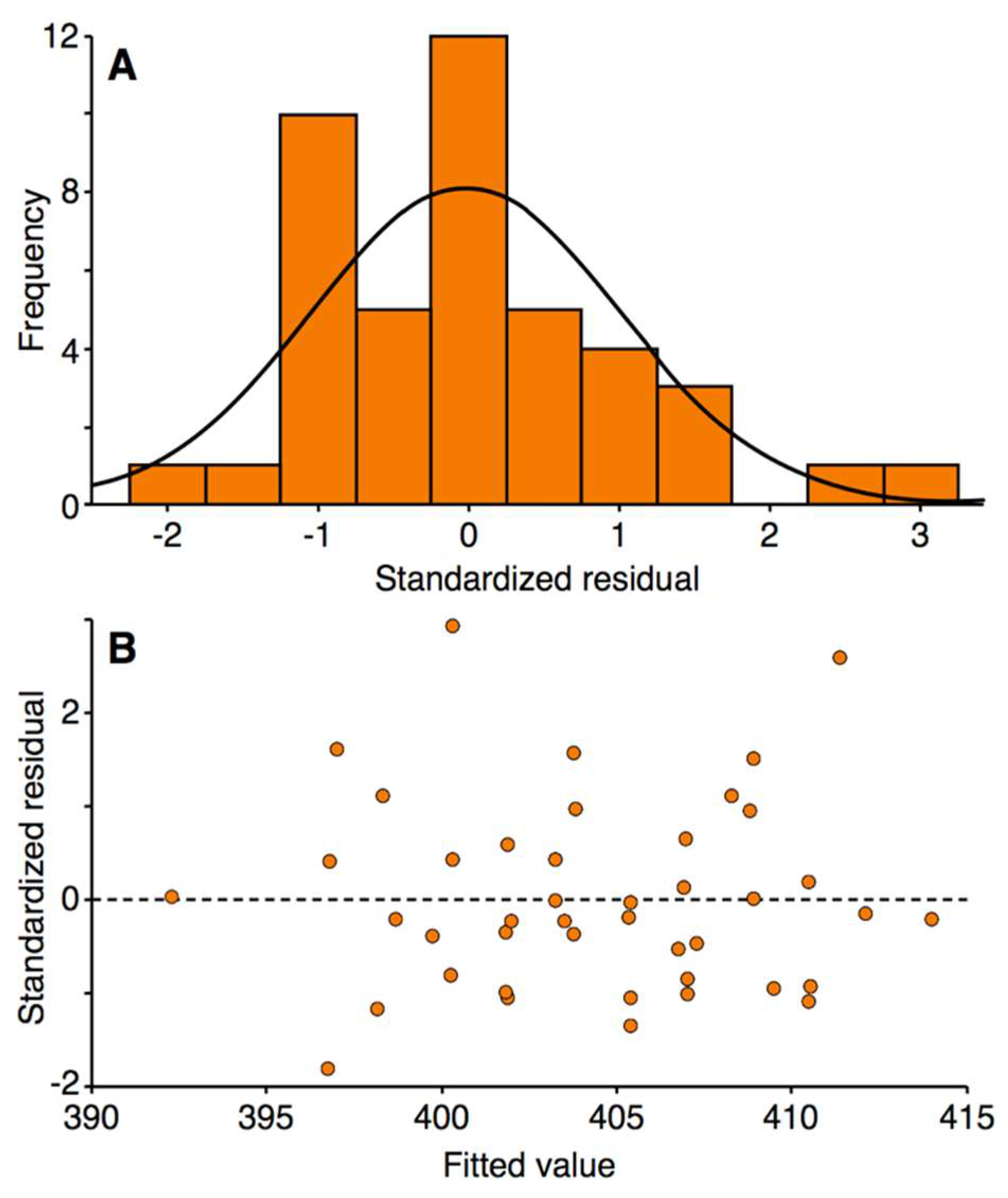
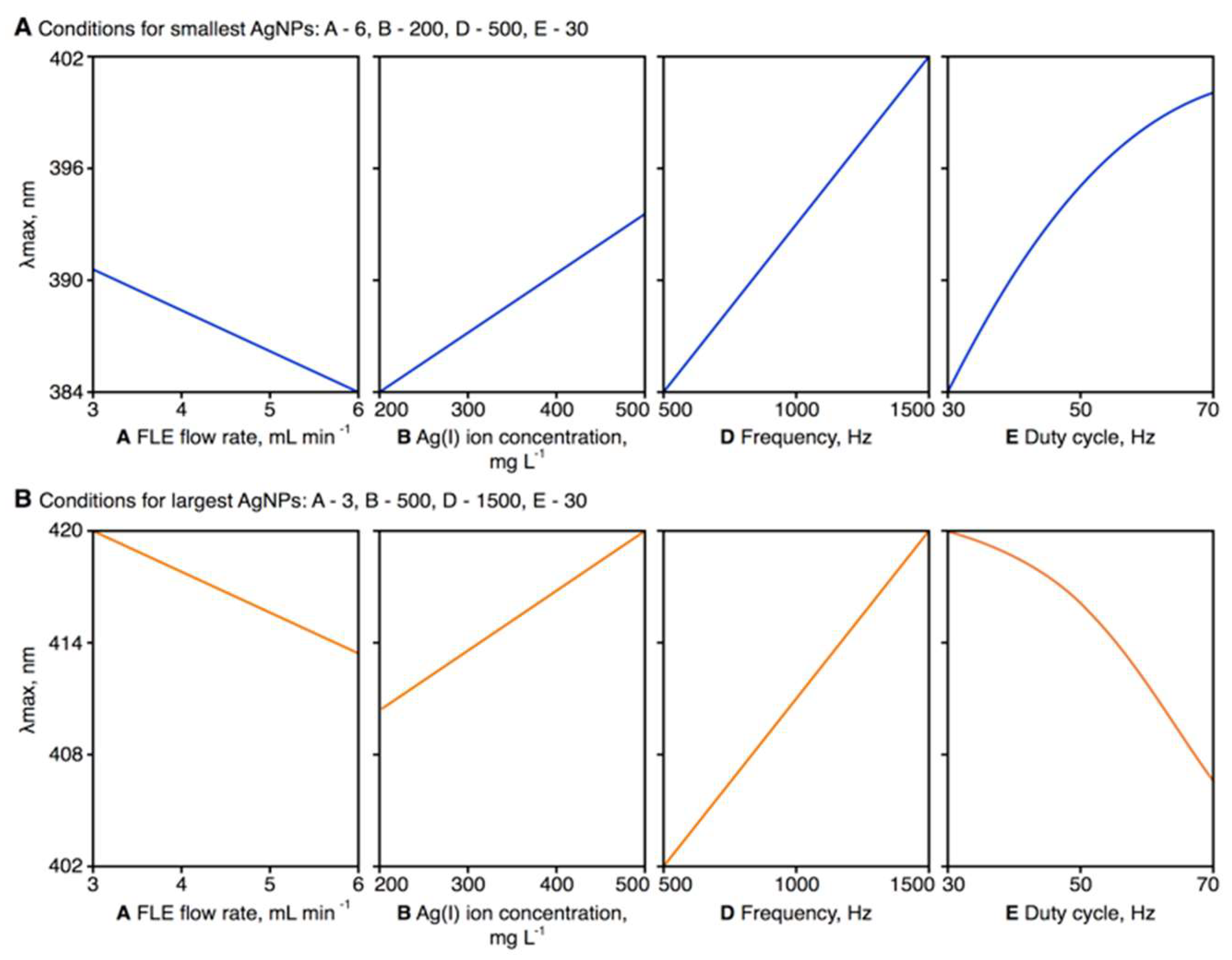
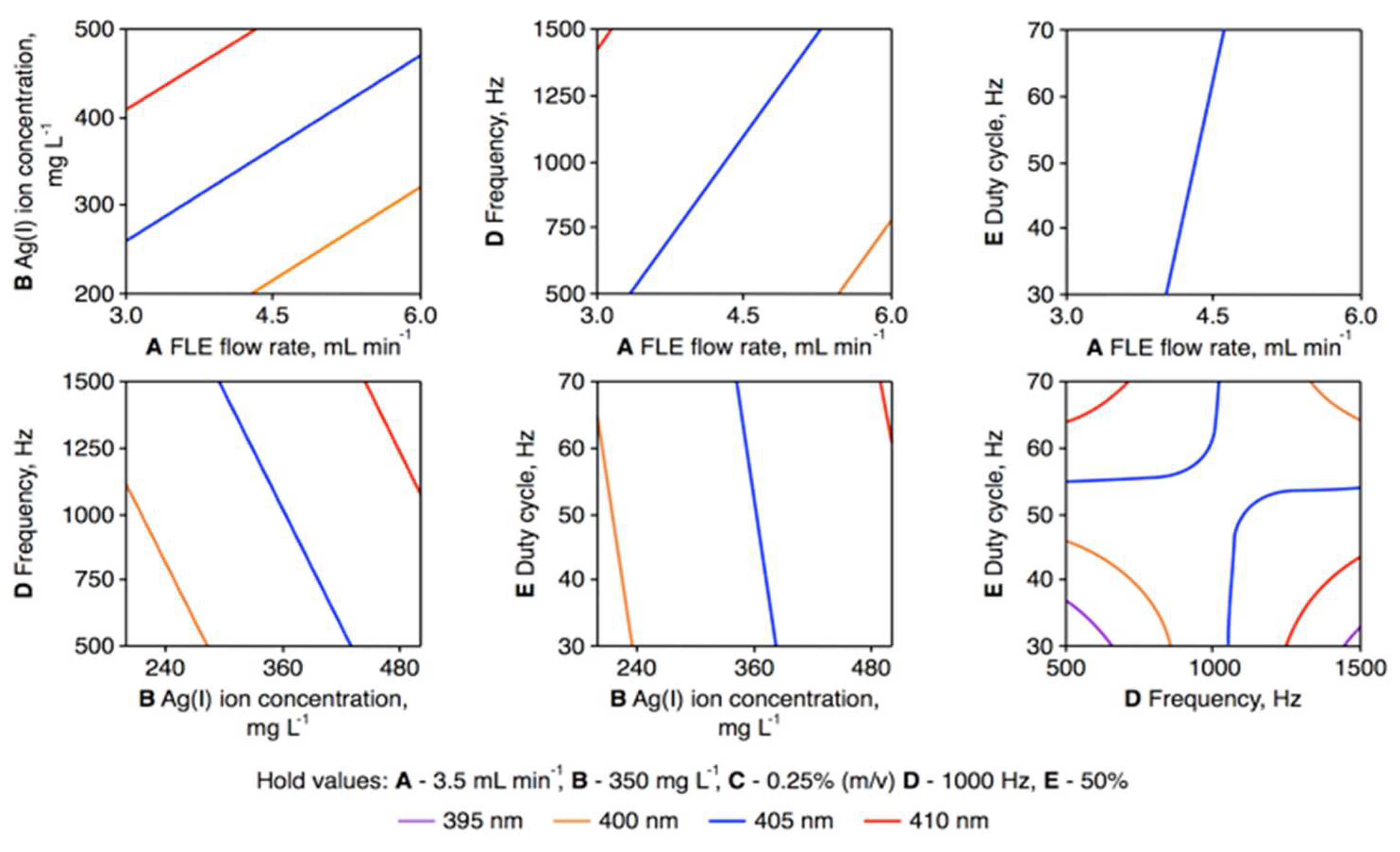
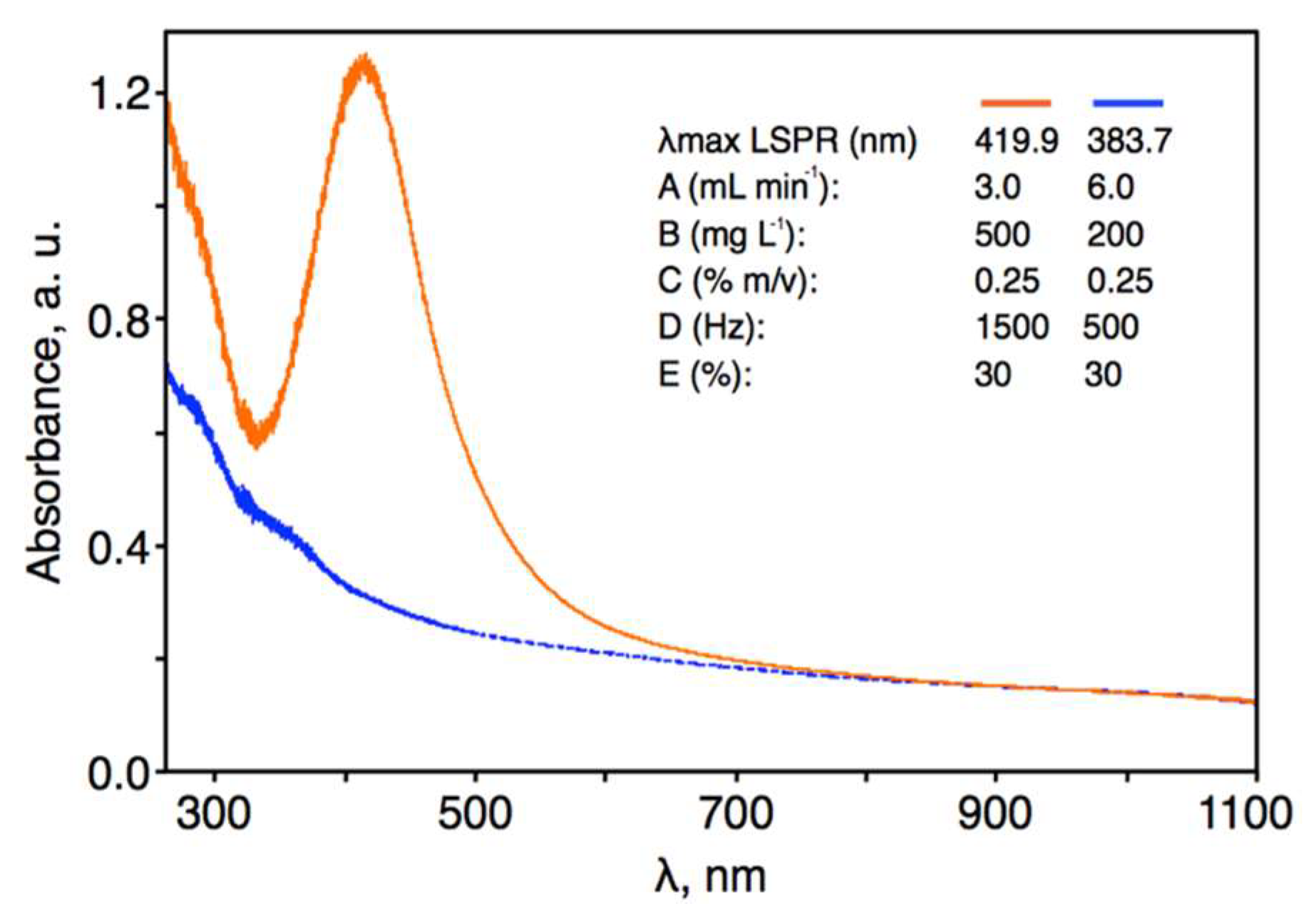
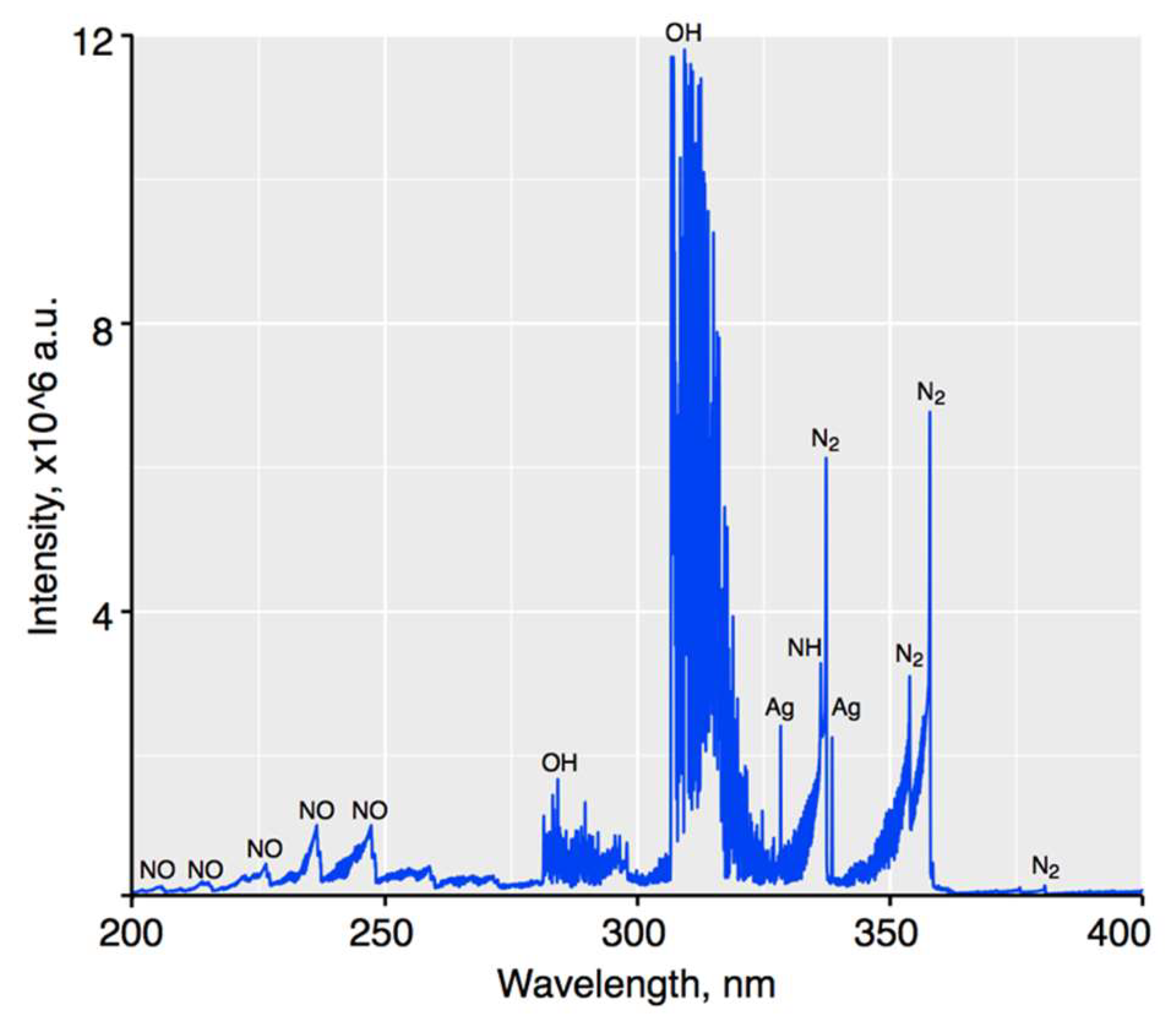
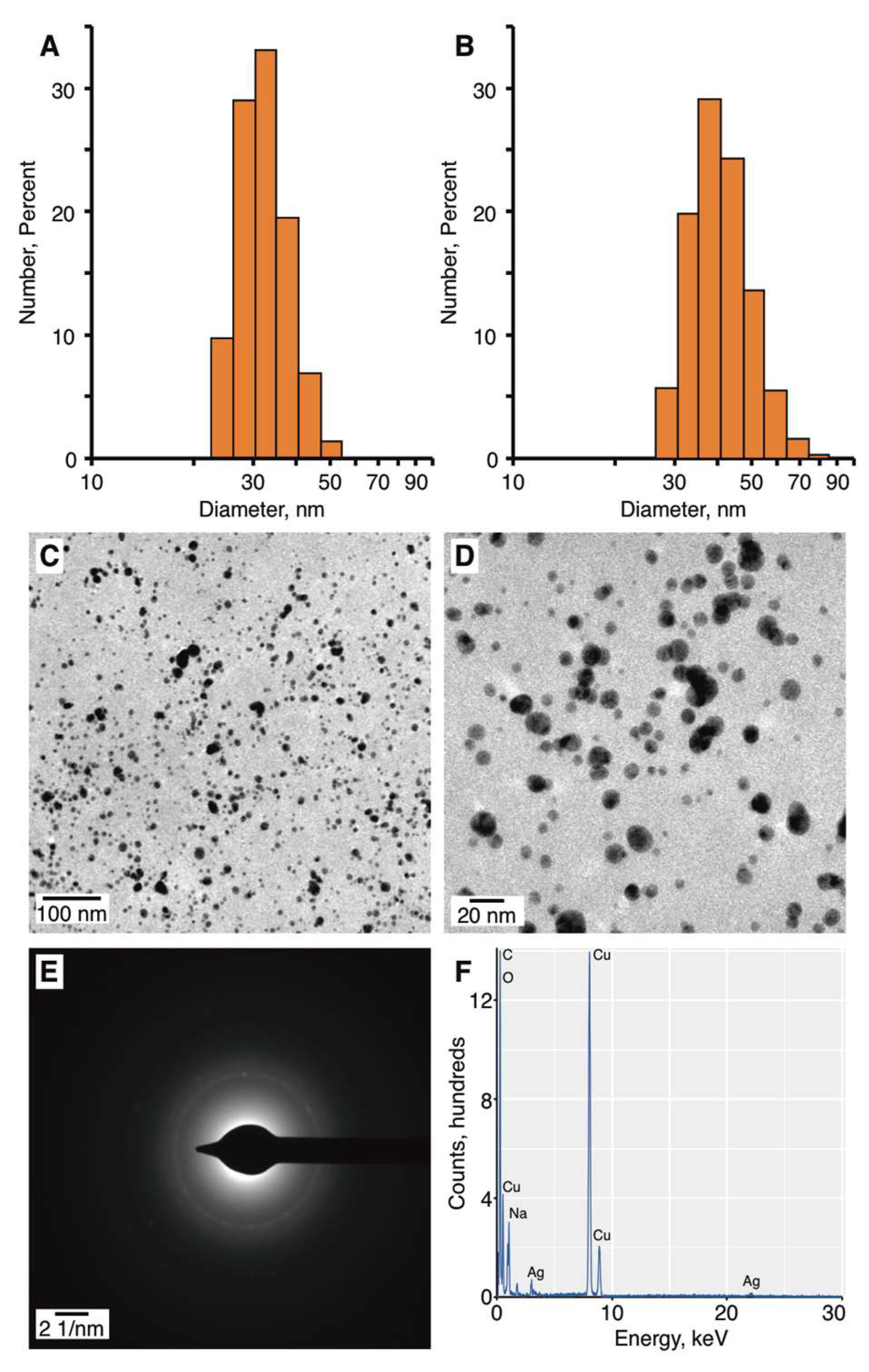
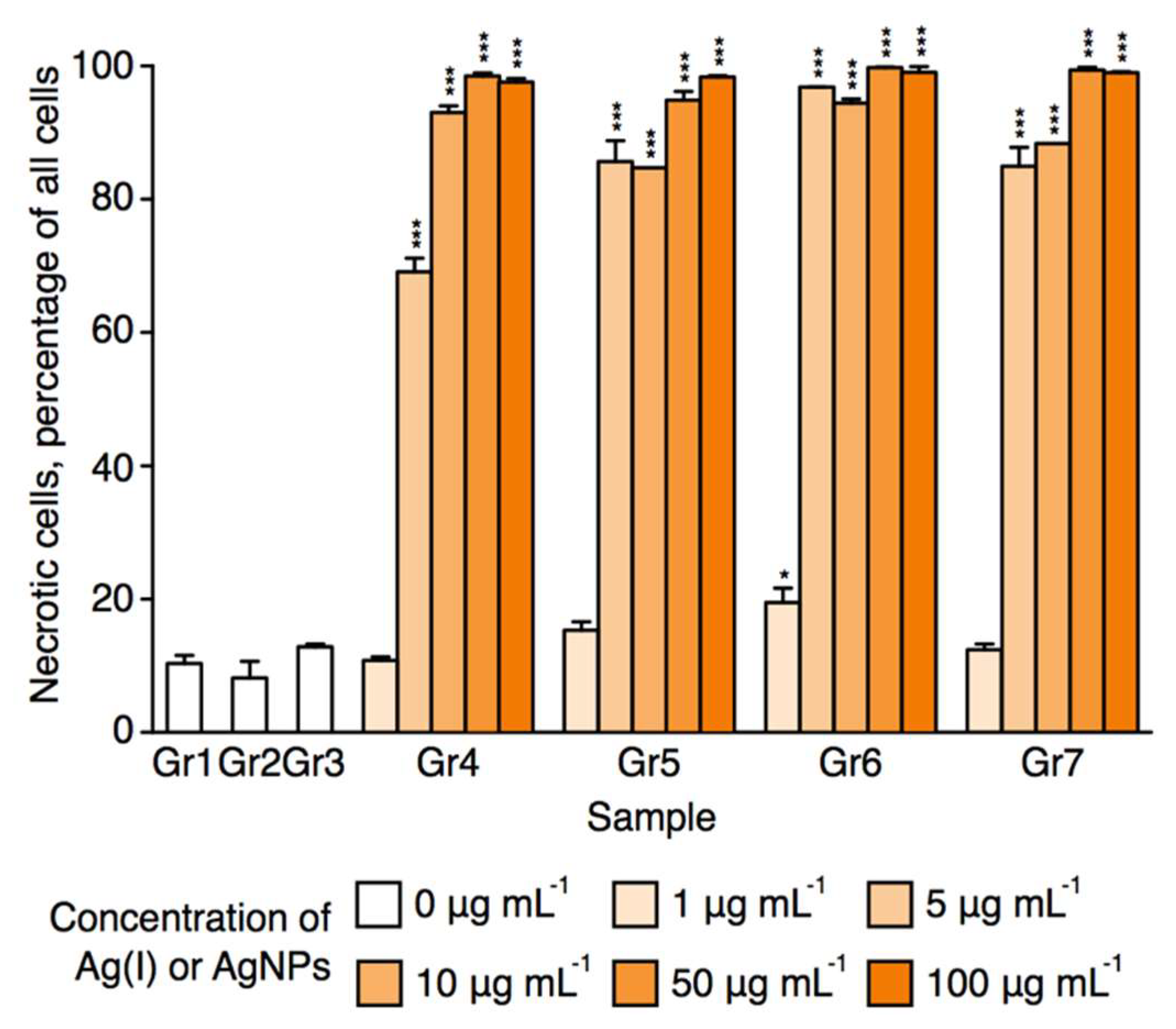
| Run Order | Actual (Coded) Levels of Operating Parameters | Response λmax (nm) | ||||
|---|---|---|---|---|---|---|
| A (mL·min−1) | B (mg·L−1) | C (%(m/v)) | D (Hz) | E (%) | ||
| 1 | 6.0 (+1) | 350 (0) | 0.25 (0) | 1500 (+1) | 50 (0) | 401.9 |
| 2 | 4.5 (0) | 350 (0) | 0.25 (0) | 500 (−1) | 70 (+1) | 404.0 |
| 3 | 3.0 (−1) | 350 (0) | 0.25 (0) | 1500 (+1) | 50 (0) | 404.0 |
| 4 | 3.0 (−1) | 350 (0) | 0.25 (0) | 500 (−1) | 50 (0) | 404.0 |
| 5 | 6.0 (+1) | 350 (0) | 0.00 (−1) | 1000 (0) | 50 (0) | 406.1 |
| 6 a | 4.5 (0) | 350 (0) | 0.25 (0) | 1000 (0) | 50 (0) | 405.1 |
| 7 | 4.5 (0) | 500 (+1) | 0.00 (−1) | 1000 (0) | 50 (0) | 402.5 |
| 8 | 4.5 (0) | 200 (−1) | 0.25 (0) | 1500 (+1) | 50 (0) | 400.3 |
| 9 | 4.5 (0) | 500 (+1) | 0.25 (0) | 500 (−1) | 50 (0) | 415.4 |
| 10 | 4.5 (0) | 500 (+1) | 0.50 (+1) | 1000 (0) | 50 (0) | 411.8 |
| 11 | 4.5 (0) | 350 (0) | 0.50 (+1) | 1500 (+1) | 50 (0) | 399.7 |
| 12 | 4.5 (0) | 200 (−1) | 0.25 (0) | 500 (−1) | 50 (0) | 397.2 |
| 13 | 4.5 (0) | 350 (0) | 0.50 (+1) | 1000 (0) | 30 (−1) | 394.7 |
| 14 | 4.5 (0) | 350 (0) | 0.00 (−1) | 1000 (0) | 30 (−1) | 399.3 |
| 15 | 3.0 (−1) | 350 (0) | 0.50 (+1) | 1000 (0) | 50 (0) | 409.0 |
| 16 | 6.0 (+1) | 350 (0) | 0.50 (+1) | 1000 (0) | 50 (0) | 394.2 |
| 17 | 4.5 (0) | 350 (0) | 0.00 (−1) | 1500 (+1) | 50 (0) | 400.8 |
| 18 | 3.0 (−1) | 500 (+1) | 0.25 (0) | 1000 (0) | 50 (0) | 412.4 |
| 19 | 3.0 (−1) | 350 (0) | 0.25 (0) | 1000 (0) | 30 (−1) | 404.0 |
| 20 | 4.5 (0) | 350 (0) | 0.50 (+1) | 500 (−1) | 50 (0) | 401.0 |
| 21 | 4.5 (0) | 350 (0) | 0.00 (−1) | 1000 (0) | 70 (+1) | 406.3 |
| 22 | 4.5 (0) | 500 (+1) | 0.25 (0) | 1000 (0) | 70 (+1) | 415.9 |
| 23 | 6.0 (+1) | 350 (0) | 0.25 (0) | 1000 (0) | 70 (+1) | 397.0 |
| 24 | 3.0 (−1) | 350 (0) | 0.25 (0) | 1000 (0) | 70 (+1) | 403.1 |
| 25 | 4.5 (0) | 200 (−1) | 0.50 (+1) | 1000 (0) | 50 (0) | 421.5 |
| 26 | 6.0 (+1) | 350 (0) | 0.25 (0) | 500 (−1) | 50 (0) | 394.6 |
| 27 | 4.5 (0) | 350 (0) | 0.00 (−1) | 500 (−1) | 50 (0) | 415.1 |
| 28 | 6.0 (+1) | 500 (+1) | 0.25 (0) | 1000 (0) | 50 (0) | 411.4 |
| 29 | 4.5 (0) | 350 (0) | 0.25 (0) | 1500 (+1) | 30 (−1) | 426.2 |
| 30 | 4.5 (0) | 500 (+1) | 0.25 (0) | 1000 (0) | 30 (−1) | 407.7 |
| 31 | 6.0 (+1) | 350 (0) | 0.25 (0) | 1000 (0) | 30 (−1) | 405.9 |
| 32 | 4.5 (0) | 200 (−1) | 0.25 (0) | 1000 (0) | 30 (−1) | 384.3 |
| 33 | 3.0 (−1) | 350 (0) | 0.00 (−1) | 1000 (0) | 50 (0) | 419.8 |
| 34 a | 4.5 (0) | 350 (0) | 0.25 (0) | 1000 (0) | 50 (0) | 397.5 |
| 35 | 4.5 (0) | 350 (0) | 0.25 (0) | 500 (−1) | 30 (−1) | 392.5 |
| 36 | 4.5 (0) | 200 (−1) | 0.25 (0) | 1000 (0) | 70 (+1) | 390.1 |
| 37 | 6.0 (+1) | 200 (−1) | 0.25 (0) | 1000 (0) | 50 (−1) | 399.7 |
| 38 a | 4.5 (0) | 350 (0) | 0.25 (0) | 1000 (0) | 50 (0) | 395.3 |
| 39 | 4.5 (0) | 350 (0) | 0.50 (+1) | 1000 (0) | 70 (+1) | 403.1 |
| 40 | 4.5 (0) | 200 (−1) | 0.00 (−1) | 1000 (0) | 50 (0) | 403.5 |
| 41 | 4.5 (0) | 500 (+1) | 0.25 (0) | 1500 (+1) | 50 (0) | 411.0 |
| 42 | 4.5 (0) | 350 (0) | 0.25 (0) | 1500 (+1) | 70 (+1) | 406.2 |
| 43 | 3.0 (−1) | 200 (−1) | 0.25 (0) | 1000 (0) | 50 (0) | 410.6 |
| Serial No. | Treatment/Compound |
|---|---|
| Group 1 (Gr1) | Cells treated with medium alone |
| Group 2 (Gr2) | Cells incubated with pectin at a concentration of 2500 mg·L−1 |
| Group 3 (Gr3) | Cells incubated with pulse-modulated radio-frequency atmospheric-pressure glow discharge (pm-rf-APGD) activated water |
| Group 4 (Gr4) | Purified silver nanoparticles (AgNPs) solution |
| Group 5 (Gr5) | Solutions of Ag(I) ions and pectin before pm-rf-APGD treatment |
| Group 6 (Gr6) | Solutions of Ag(I) ions before pm-rf-APGD treatment |
| Group 7 (Gr7) | Non-purified AgNPs solution, containing unreacted Ag(I) ions |
| Source of Data | DF | Adjusted SS | Adjusted MS | F-Value b | p-Value |
|---|---|---|---|---|---|
| Model | 6 | 988.09 | 164.68 | 2.84 | 0.023 |
| Linear | 4 | 657.69 | 164.42 | 2.84 | 0.038 |
| A | 1 | 196.70 | 196.70 | 3.39 | 0.074 |
| B | 1 | 410.06 | 410.06 | 7.08 | 0.012 |
| D | 1 | 43.23 | 43.23 | 0.75 | 0.393 |
| E | 1 | 7.70 | 7.70 | 0.13 | 0.718 |
| Square | 1 | 82.33 | 82.33 | 1.42 | 0.241 |
| E2 | 1 | 82.33 | 82.33 | 1.42 | 0.241 |
| Two-way interactions | 1 | 248.06 | 248.06 | 4.28 | 0.046 |
| DE | 1 | 248.06 | 248.06 | 4.28 | 0.046 |
| Error | 36 | 2086.15 | 57.95 | - | - |
| Lack-of-fit | 34 | 2033.27 | 59.80 | 2.26 | 0.354 |
| Pure error | 2 | 52.88 | 26.44 | - | - |
| Total | 42 | 3074.24 | - | - | - |
© 2018 by the authors. Licensee MDPI, Basel, Switzerland. This article is an open access article distributed under the terms and conditions of the Creative Commons Attribution (CC BY) license (http://creativecommons.org/licenses/by/4.0/).
Share and Cite
Dzimitrowicz, A.; Bielawska-Pohl, A.; DiCenzo, G.C.; Jamroz, P.; Macioszczyk, J.; Klimczak, A.; Pohl, P. Pulse-Modulated Radio-Frequency Alternating-Current-Driven Atmospheric-Pressure Glow Discharge for Continuous-Flow Synthesis of Silver Nanoparticles and Evaluation of Their Cytotoxicity toward Human Melanoma Cells. Nanomaterials 2018, 8, 398. https://doi.org/10.3390/nano8060398
Dzimitrowicz A, Bielawska-Pohl A, DiCenzo GC, Jamroz P, Macioszczyk J, Klimczak A, Pohl P. Pulse-Modulated Radio-Frequency Alternating-Current-Driven Atmospheric-Pressure Glow Discharge for Continuous-Flow Synthesis of Silver Nanoparticles and Evaluation of Their Cytotoxicity toward Human Melanoma Cells. Nanomaterials. 2018; 8(6):398. https://doi.org/10.3390/nano8060398
Chicago/Turabian StyleDzimitrowicz, Anna, Aleksandra Bielawska-Pohl, George C. DiCenzo, Piotr Jamroz, Jan Macioszczyk, Aleksandra Klimczak, and Pawel Pohl. 2018. "Pulse-Modulated Radio-Frequency Alternating-Current-Driven Atmospheric-Pressure Glow Discharge for Continuous-Flow Synthesis of Silver Nanoparticles and Evaluation of Their Cytotoxicity toward Human Melanoma Cells" Nanomaterials 8, no. 6: 398. https://doi.org/10.3390/nano8060398
APA StyleDzimitrowicz, A., Bielawska-Pohl, A., DiCenzo, G. C., Jamroz, P., Macioszczyk, J., Klimczak, A., & Pohl, P. (2018). Pulse-Modulated Radio-Frequency Alternating-Current-Driven Atmospheric-Pressure Glow Discharge for Continuous-Flow Synthesis of Silver Nanoparticles and Evaluation of Their Cytotoxicity toward Human Melanoma Cells. Nanomaterials, 8(6), 398. https://doi.org/10.3390/nano8060398









